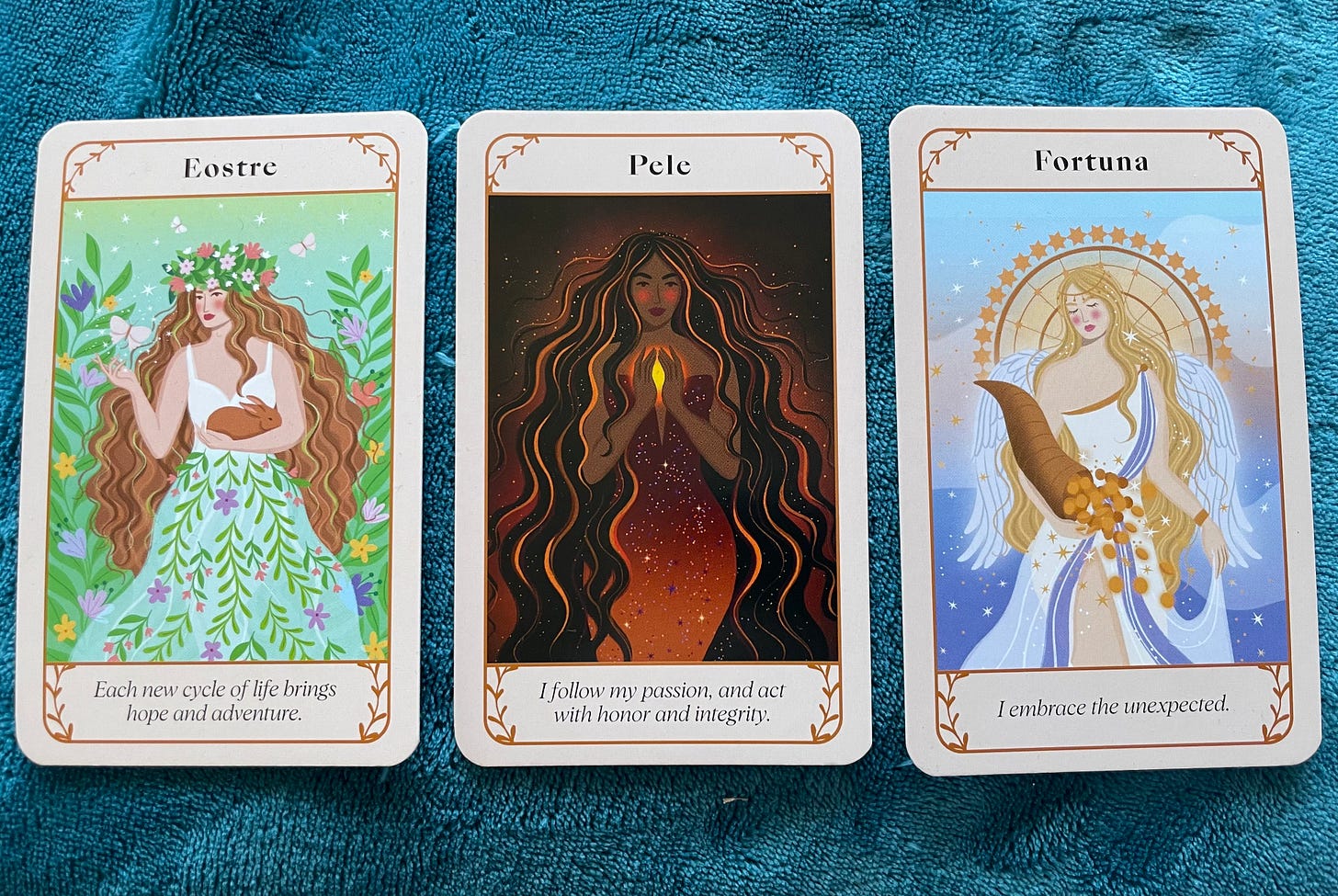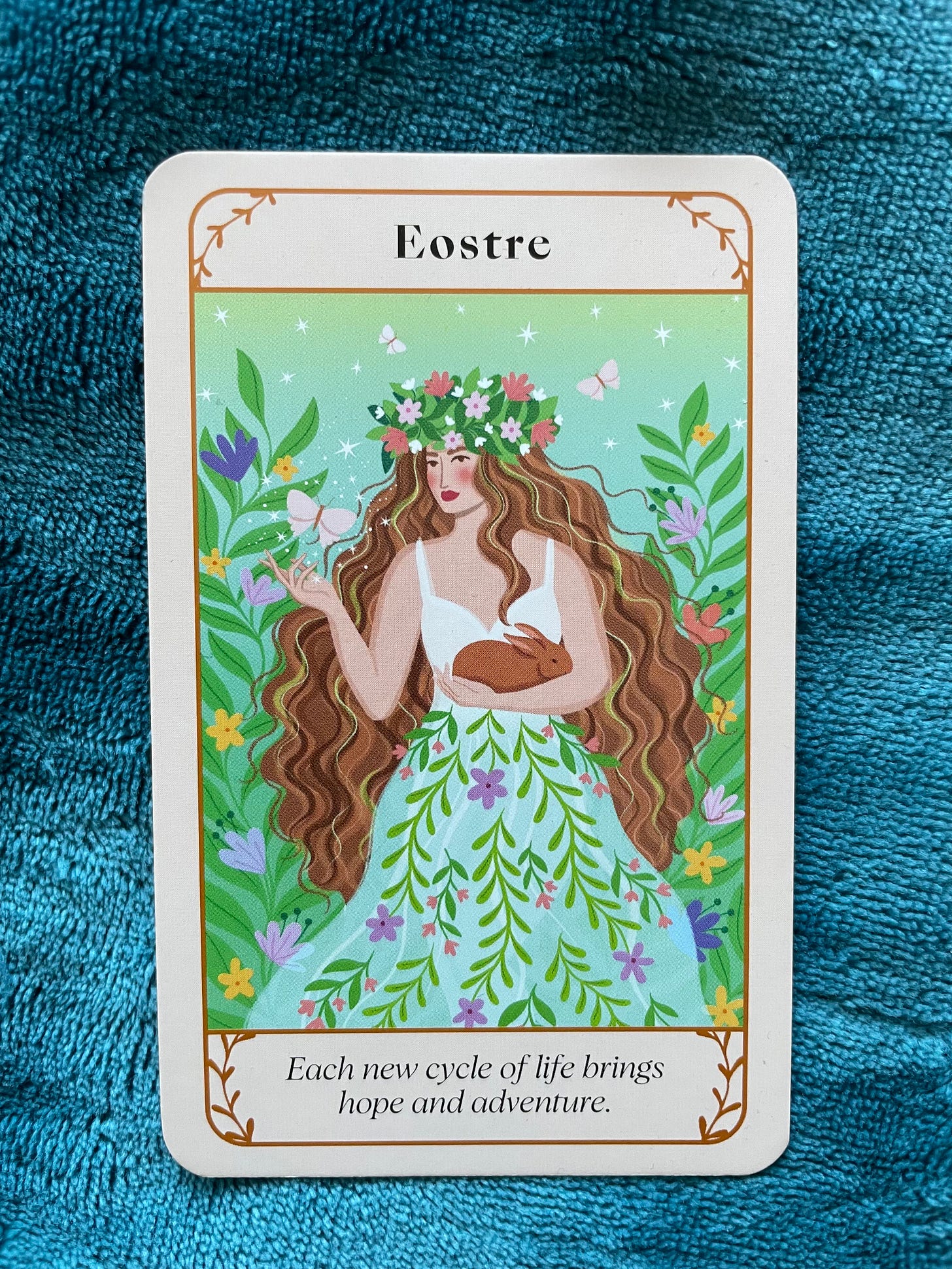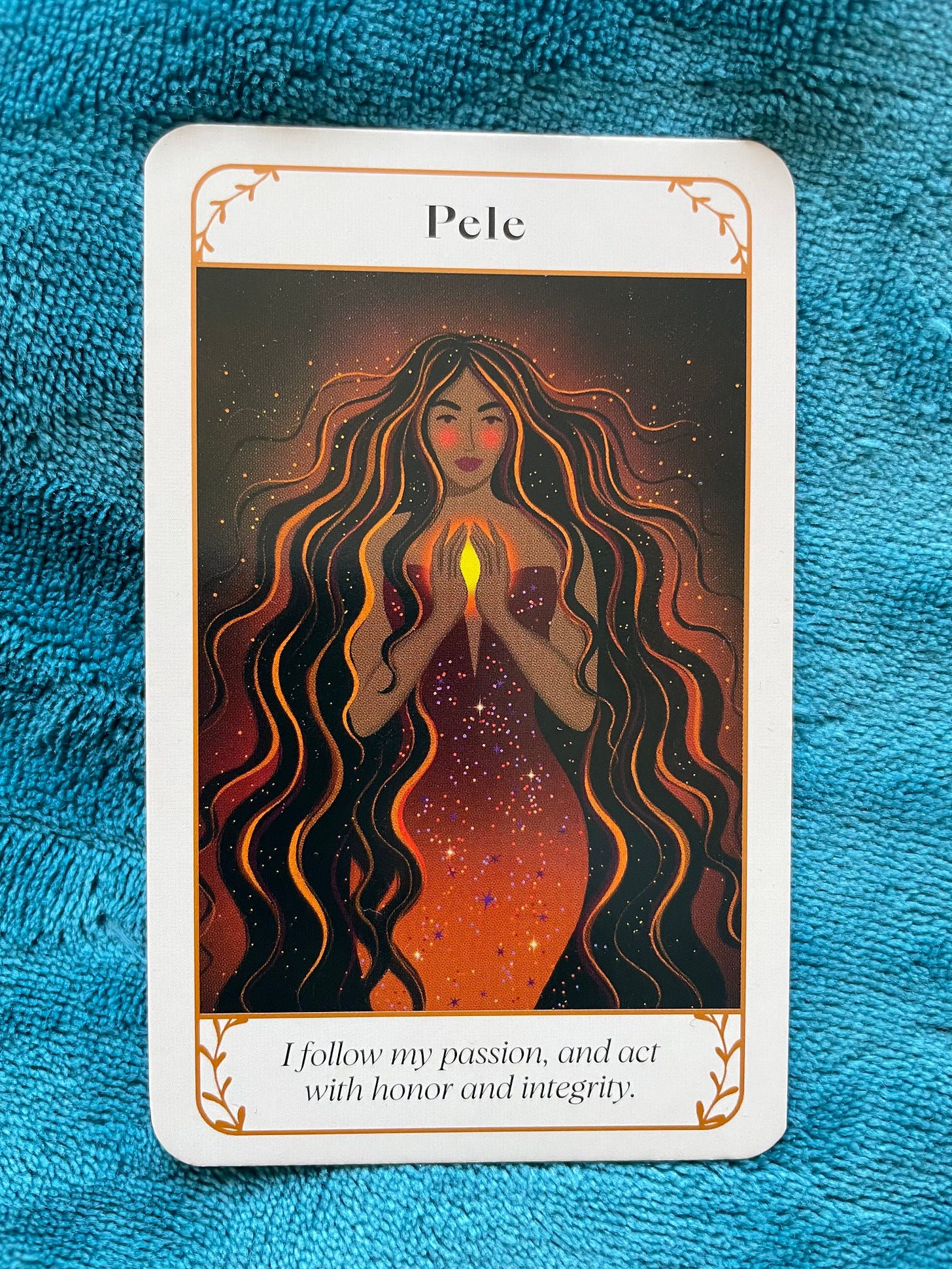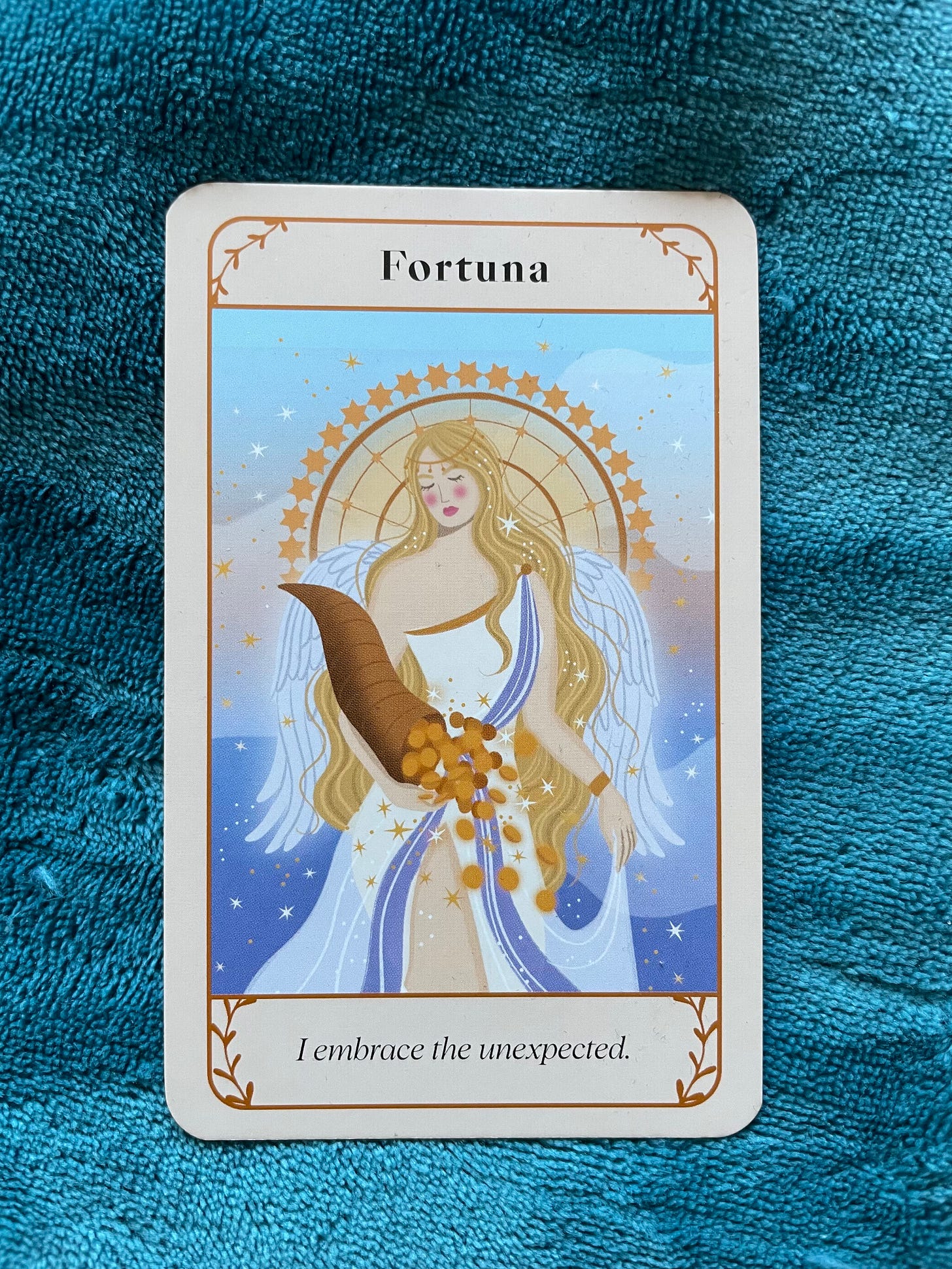Welcome to The Autumn Chronicles, a place to shine a light on all the wonder around us as we navigate the seasons. I hope these writings allow you to sit quietly with a cup of something warm and comforting and take a few moments for yourself away from the rush and hurry. If you would like to make sure you get all newsletters directly to your inbox, please subscribe below. Thank you for being here. All photos © The Autumn Chronicles.
This piece is written as part of the IWD Siren Songs initiative by
, , , , Georgia Garnett, and .I am new to the world of oracle cards and indeed, I only learnt about them through reading some of the wonderful posts on this platform. I am now the proud owner of a few different decks and mainly use them as a kind of framework for how to think about things. If I am struggling with what to do in a situation, I will pull a card and use it as inspiration to solve the problem. If I want to set an intention, or tone, for the day, week, month or year ahead, I will pick a deck, think about how I want the time to feel and then shuffle the cards, allowing myself to be guided by the seemingly random nature of the pull to gain a sense of perspective. Sometimes I will repeat the process across multiple decks and use the cards in conjunction to try and get a big-picture view of where it will best serve me to spend my time, energy and attention. If nothing else, it helps me to hone and focus, allowing me to cut through the incessant chatter of my mind, and is the closest I come to leaving anything to chance.
One of my favourite decks to use is the Goddess Oracle Deck by Katja Perez. It draws on the mythology and narratives of 50 different female deities from around the world and is intended to help us connect with our own gifts and talents by examining the attributes and stories of these goddesses. Even if oracle cards are not your thing, it is still fascinating to learn more about how ancient religions saw the world and about how the similarity of ideas and concepts from different places at different times connected various groups of people in a common landscape.
According to Collins Dictionary1, a goddess is:
a female spirit or being that is believed to have power over a particular part of the world or nature.
Across history, goddesses have been linked to typically feminine roles, traits or behaviours that conform to how women and girls are perceived and that accord with the way they are expected to conduct themselves. Even goddesses exist within a typically patriarchal society and are often used as examples of manipulation and cunning, painted as being solely responsible for the downfall of men through their tricks and lies2, as if the men in question have no free will or decision-making capability of their own. We are reminded of the sirens, luring sailors to their deaths on the rocks through their hypnotic singing although this narrative of women as deceitful conveniently forgets poor Persephone, tricked by Hades into eating pomegranate seeds and thereby condemning her to spend part of the year in the underworld. Or even the many stories of goddesses, mortal women and nymphs who were deceived by the gods themselves, often at great personal cost.
When I decided that goddesses would be my theme for this piece of writing, I pulled three cards from the Goddess Oracle Deck: one to represent the past, one to represent the present and one to represent the future, as a way of framing the mythology of the goddesses alongside the life stages that we all experience. My interpretations for these cards are narrow, fairly cosmetic (although perhaps a deep dive into goddess mythology will form the basis for a future post) and solely based on my own experiences and traditions (and oftentimes guesswork where there is a lack of primary source material). Depending on where you come from and what you believe, there will be many other interpretations that may be more meaningful to you and I would love for you to share those in the comments.
Eostre
My pull for the past was Eostre, goddess of the dawn and of spring. She is found in Anglo-Saxon, Celtic and Germanic traditions and was mentioned by the Venerable Bede, an English historian, in his seventh century work, The Reckoning of Time. Linked to Ostara, the pagan festival celebrating the spring equinox, and believed to have lent her name to the Christian festival of Easter, Eostre encourages us to pay attention to new beginnings, hope, growth and an awareness of life’s cycles and rhythms. Wildflowers are believed to have sprung wherever she walked and she is a wonderful reminder that life, like nature, happens in seasons.
Jacob Grimm of Brothers Grimm fairytale fame said of Eostre:
Eostre seems therefore to have been the divinity of the radiant dawn, of upspringing light, a spectacle that brings joy and blessing, whose meaning could be easily adapted by the resurrection-day of the Christian’s God.
Although the Christian tradition associates Easter with the resurrection of the male Jesus, some believe that Eostre had been blazing a trail for the divine feminine before Christianity became a widely accepted religious tradition. Eostre, like Jesus, represents a reawakening after the darkness of winter (or death), rising from the cold earth (or the tomb) to bring new light and hope to the world. She represents another thread in the fabric of interconnectivity that binds us all together no matter our beliefs, traditions, customs or cultures.
Pele
For the present, I pulled Pele; not the footballer but the Hawaiian goddess of fire, volcanoes and dance. Closely associated with the traits of passion, protection, freedom and honour, she is also known as the “woman who devoured the earth” due to her ability to cover the land with molten lava, therefore containing within herself both creative and destructive forces. She is characterised as a wanderer, refusing to be limited or to follow rules and being led solely by her passions and her desire to carve her own path.
There are many origin stories for Pele (and when reading them, it is very interesting to see how many have informed the plot of the Disney film, Moana) but one story tells of how she was banished from her home island of Tahiti by her father after it was discovered that she was having an affair with her sister’s husband (it is unclear what punishment the husband suffered but as he was equally culpable, he must have shared half the punishment, right? Right?!). Her sister, Namakaokahai, was the goddess of the sea and as she pursued Pele, she unleashed torrents of water to cover the earth, leaving nothing behind. Pele, in response, filled great openings with her lava, creating the islands and the volcanos for which Hawaii is famous today and allowing her to protect her home and herself from her sister.
Pele represents the freedom of forging your own path and the importance of making peace with your mistakes to allow you to act from a place of truth. She is strong and assertive, courageous and bold, showing that age and maturity allow us to harness our determination and fortitude, no matter what mistakes we may have made when we were younger.
Fortuna
My final pull, to represent the future, was Fortuna, the Roman goddess of fate and fortune. Otherwise known as the goddess of abundance and gratitude, she reminds us that life cannot be controlled and that we need to be ready to meet the unexpected with grace and to be grateful for what we have. She is often pictured balancing on a ball to symbolise the uncertain nature of fate, with a rudder to show that life can shift direction at any moment or holding a cornucopia, to show the potential for abundance and plenty.
As seems to be typical for goddesses, she was often blamed for bad luck when it was felt that those who had prayed to her and left offerings were not sufficiently rewarded. Fortuna’s message is that she cannot control fate and that the wheel of life will always turn, meaning that sometimes we are at the top and other times we are at the bottom. The most important part of living is to allow situations to unfold as they will, celebrating the good times and ensuring that we are ready and able to sustain the times when life does not go our way.
In this context, Fortuna is the perfect card to represent the future. Life is unpredictable, the future unwritten and almost entirely a game of chance but we can choose how we face it. By taking each day as it comes, being thankful for what we have and ready to endure what we cannot control, we allow ourselves to experience the true nature and meaning of life with all its joys and sorrows.
If you have enjoyed this post or if something has resonated with you, please share to help others find The Autumn Chronicles. I am so grateful to you for being here and for choosing to read these words.
https://www.collinsdictionary.com/dictionary/english/goddess
There is an excellent paper online about this, especially pertaining to goddesses in Ancient Greece: https://digitalcommons.georgiasouthern.edu/cgi/viewcontent.cgi?article=1022&context=aujh














I really like this Victoria. I'd never heard of these cards before (perhaps I've been living under a rock?) but I'm certainly intrigued to learn more 😀
Thank you for sharing, stories we need to know and to remember! I also love Oracle cards and use them more and more... Recently fell in love with the 'Seasons of the Witch Ostara Oracle' which I have to try yet 😊